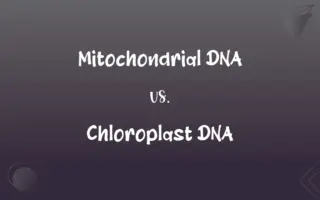Silicone vs. Siloxane: What's the Difference?
Edited by Aimie Carlson || By Janet White || Published on January 17, 2024
Silicone is a synthetic polymer made from silicon, oxygen, carbon, and hydrogen, used in a wide range of products. Siloxane is a chemical group forming the backbone of silicone polymers, consisting of alternating silicon and oxygen atoms.
Key Differences
Silicone is a versatile synthetic polymer widely used in various industries, made from silicon, oxygen, carbon, and hydrogen. Siloxane refers specifically to the chemical structure within silicone, consisting of alternating silicon and oxygen atoms.
Silicones, due to their flexibility and heat resistance, are used in cookware, medical devices, and sealants. Siloxane groups are the key structural elements that give silicones these unique properties.
Silicone products range from fluids and gels to hard resins, adaptable to numerous applications. Siloxane, as a chemical group, determines the physical and chemical properties of these silicone-based materials.
In the cosmetic industry, silicones are used for their smoothing and moisturizing effects. The presence of siloxane bonds in these silicones provides the desired texture and stability in cosmetic formulations.
Environmental considerations for silicone include its biodegradability and impact. Siloxane compounds, particularly cyclic siloxanes, are monitored for their environmental persistence and potential effects.
ADVERTISEMENT
Comparison Chart
Composition
Made from silicon, oxygen, carbon, hydrogen
Chemical group consisting of silicon and oxygen atoms
Properties
Flexible, heat resistant
Determines physical and chemical properties of silicone
Uses
Cookware, medical devices, cosmetics
Foundational structure in silicone materials
Forms
Fluids, gels, resins
Chemical bonds within silicone polymers
Environmental Impact
Biodegradability and safety concerns
Persistence and potential environmental effects
ADVERTISEMENT
Silicone and Siloxane Definitions
Silicone
Known for its flexibility and durability.
Silicone sealants are used for waterproofing in construction.
Siloxane
A chemical group in silicone polymers.
The siloxane bond contributes to the flexibility of silicone rubbers.
Silicone
Employed in cosmetic products for texture.
Many hair conditioners contain silicone for smoothness.
Siloxane
Monitored for environmental impact.
Environmental studies often focus on the breakdown of siloxanes.
Silicone
A synthetic polymer used in a variety of products.
The kitchen spatula is made of heat-resistant silicone.
Siloxane
Influences the physical properties of silicones.
The length of the siloxane chain affects the viscosity of silicone products.
Silicone
Can be formulated as fluids, gels, or resins.
Silicone oil is used as a lubricant in various machinery.
Siloxane
Found in cyclic and linear forms in silicones.
Cyclic siloxanes are used as intermediates in silicone manufacturing.
Silicone
Used in medical devices for its biocompatibility.
Silicone is commonly used in prosthetic limbs.
Siloxane
Characterized by silicon-oxygen chains.
Siloxane chains are responsible for the unique properties of silicone materials.
Silicone
Any of a large group of oligomers and polymers based on the structural unit R2SiO, where R is an organic group, characterized by wide-range thermal stability, high lubricity, extreme water repellence, and physiological inertness and used in adhesives, lubricants, protective coatings, paints, electrical insulation, synthetic rubber, and prosthetic replacements for body parts.
Siloxane
Any of a class of chemical compounds of silicon, oxygen, and hydrogen, based on the repeating structural unit H2SiO.
Silicone
(chemistry) Any of a class of inert, semi-inorganic polymeric compounds (polysiloxanes), that have a wide range of thermal stability and extreme water repellence, used in a very wide range of industrial applications, and in prosthetic replacements for body parts.
Siloxane
(chemistry) Any of a class of compound having a short repeating unit of silicon and oxygen atoms (either in a chain or a ring), typically with organic side chains
Silicone
(transitive) To join or treat (something) with a silicone-based product.
Silicone the bathtub to the tile
Siloxane
Any of a large class of compounds that have alternate silicon and oxygen atoms
Silicone
To enhance or reconstruct (a body part) with a prosthesis containing silicone.
Silicone
Any of a large class of siloxanes that are unusually stable over a wide range of temperatures; used in lubricants and adhesives and coatings and synthetic rubber and electrical insulation
FAQs
What is siloxane?
Siloxane is a chemical group consisting of alternating silicon and oxygen atoms, forming the backbone of silicone polymers.
Is siloxane found in all silicone products?
Yes, siloxane is a fundamental component of all silicone polymers.
What is silicone?
Silicone is a synthetic polymer used in various applications, known for its flexibility and heat resistance.
What role does siloxane play in silicone?
Siloxane determines the physical and chemical properties of silicone materials.
How does siloxane affect silicone's properties?
The structure and length of siloxane chains influence the flexibility, durability, and viscosity of silicone products.
Can silicone be used in high-temperature applications?
Yes, silicone is known for its heat resistance and is often used in high-temperature applications.
Where is silicone commonly used?
Silicone is used in cookware, medical devices, sealants, and cosmetics.
Are silicone products environmentally safe?
The environmental safety of silicone products varies; they are generally stable but can have concerns regarding biodegradability.
Are there different types of siloxane?
Yes, siloxanes can be cyclic or linear, each with different properties and uses.
Can silicone be recycled?
Recycling silicone can be challenging due to its chemical stability, but some recycling methods do exist.
How are silicone and siloxane related?
Siloxane is the chemical structure within silicone that gives it its unique properties.
Are siloxanes toxic?
The toxicity of siloxanes varies; some forms can be environmentally persistent, requiring careful monitoring.
How are siloxanes used in manufacturing?
Siloxanes are used as intermediates in the production of various silicone materials and products.
How is silicone made?
Silicone is synthesized from silicon, oxygen, carbon, and hydrogen through chemical processes.
Do siloxanes pose environmental risks?
Certain siloxanes, like cyclic siloxanes, are monitored for their persistence and potential environmental effects.
Is silicone used in medical implants?
Yes, silicone is widely used in medical implants due to its biocompatibility.
How does siloxane contribute to silicone's heat resistance?
The siloxane bond's stability contributes to silicone's ability to withstand high temperatures.
What are the disadvantages of silicone?
Disadvantages of silicone include potential environmental impact and difficulties in recycling.
Can silicone be used in food applications?
Yes, food-grade silicone is used in cookware and kitchen utensils.
What makes silicone popular in the cosmetic industry?
Silicone's smoothing and moisturizing effects make it popular in cosmetics.
About Author
Written by
Janet WhiteJanet White has been an esteemed writer and blogger for Difference Wiki. Holding a Master's degree in Science and Medical Journalism from the prestigious Boston University, she has consistently demonstrated her expertise and passion for her field. When she's not immersed in her work, Janet relishes her time exercising, delving into a good book, and cherishing moments with friends and family.
Edited by
Aimie CarlsonAimie Carlson, holding a master's degree in English literature, is a fervent English language enthusiast. She lends her writing talents to Difference Wiki, a prominent website that specializes in comparisons, offering readers insightful analyses that both captivate and inform.







































































